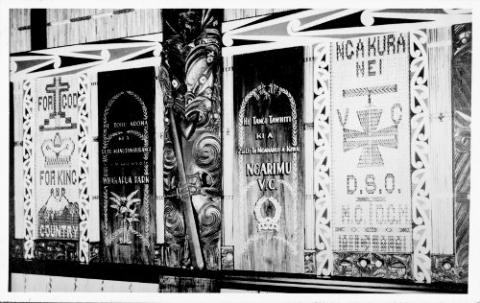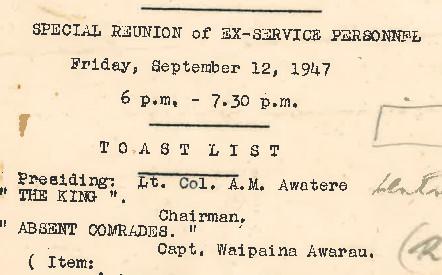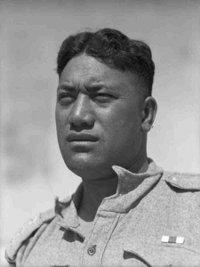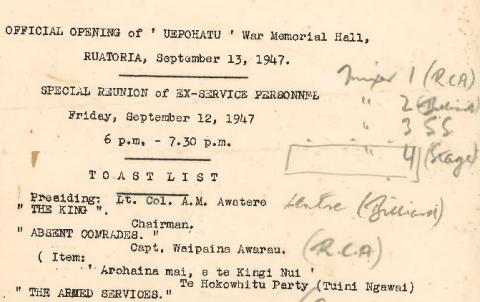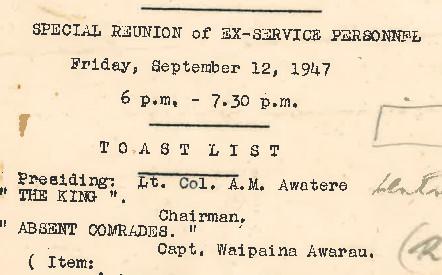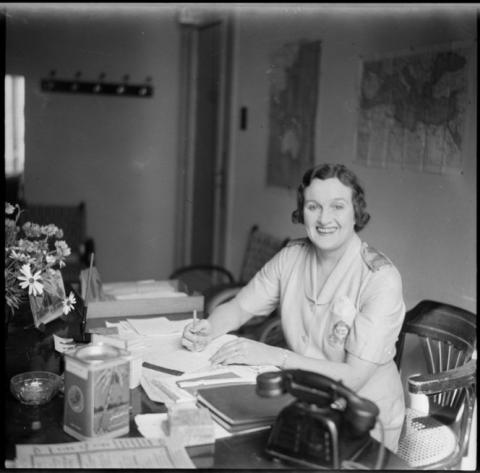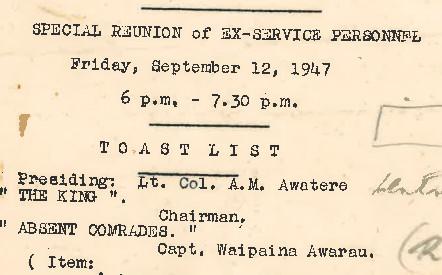<p><strong>Hiruharama School perform the song ‘Karangatia ra’ and the <acronym title="dance of challenge and welcome; chant with accompanying actions">haka</acronym> 'Ruaumoko’ during competitions held at Uepohatu Marae in 1947. <em> </em></strong></p><p class="MsoNormal" style="margin: 0cm 0cm 8pt;"><strong>‘Karangatia ra’ was originally composed by Sir Apirana Ngata for the return of the Pioneer Battalion from World War I. This version has been adapted slightly for this event.</strong><br /><br /><strong>In another <a href="/node/16669#Ruaumoko" target="_blank">sound recording</a> Sir Apirana Ngata attributes the classic East Coast haka 'Ruaumoko' to the ancestor Taki o te rangi. </strong></p><p class="MsoNormal" style="margin: 0cm 0cm 8pt;">The <acronym title=" open space or courtyard where people gather, generally in front of a main building or meeting house; forum of social life; modern meaning: the complex of buildings surrounding the courtyard and the courtyard itself">marae </acronym><em></em>hosted events held on the 12th and 13th of September that included cultural competitions with local school children, the opening of the Uepohatu War Memorial Hall, a reunion of ex-service people (including members of the Maori Battalion), a concert and the opening of the Uepohatu War Memorial Hall. The hall was built to commemorate East Coast soldiers who died during the two World Wars. </p><p>At an investiture ceremony held on the second day, seventeen decorations were presented to servicemen and women who had served abroad and on the home front.</p><p>The gathering was an important one, attended by thousands including the Prime Minister Peter Fraser, the Leader of the Opposition Sidney Holland and other members of Parliament. Sir Bernard Freyberg, the Governor General opened the hall and unveiled two memorial tablets inside.</p><p> </p><h2>Transcript</h2><p>Karangatia ra, karangatia ra<br />Powhiritia ra<br />Nga iwi o te motu<br />Nga mano tini<br />Haere mai<br />He hui aroha<br />Mo nga hoia<br />E ngau te aroha me te mamae</p><p>Haere mai e nga iwi<br />Haere mai e nga toa<br />Nau mai te kawana<br />Nga mana tiketike <br />Honoa mai te aroha<br />Haere mai<br />Nga ohaki a nga tupuna<br />E ngau nei te aroha me te mamae</p><p>Nau ra e Api<br />Nau ra e koro<br />Wero ki taku uma<br />Titi rawa i te manawa<br />Oho ana te mauri, aue ra<br />Taonga tukuiho a nga tupuna<br />E ngau nei te aroha me te mamae, hi<br /><br /></p>
Media library
Audio
<p><strong>Sound file</strong> from Ngā Taonga Sound & Vision, ref: <a href="https://www.ngataonga.org.nz/collections/catalogue/catalogue-item?recor…;. Any re-use of this audio is a breach of copyright.</p><p><strong>Image </strong>Tukutuku panels for the Uepohatu Hall, Ruatoria - Photograph taken by Owen Johnson. Mackrell, Brent :Photographs relating to Poverty Bay. Ref: PA1-o-1038-20. Alexander Turnbull Library, Wellington, New Zealand. <a href="http://natlib.govt.nz/records/23108856">http://natlib.govt.nz/records/2…;
<p><strong>Tikitiki school perform the song ‘Karangatia ra’ and the <acronym title="dance of challenge and welcome; chant with accompanying actions">haka</acronym> ‘Paikea’ during competitions held at Uepohatu marae in 1947. </strong></p><p><strong>‘Karangatia ra’ was originally composed by Sir Apirana Ngata for the return of the Pioneer Battalion from World War I. This version has been adapted slightly for this event.</strong><br /><br /><strong>The haka ‘Paikea’ tells the story of the ancestor and his journey from Hawaiki on the back of a whale. He settled at Whangara marrying Huturangi and so joining his genealogical line with that of the navigator Te Whironui. </strong></p><p>The <acronym title=" open space or courtyard where people gather, generally in front of a main building or meeting house; forum of social life; modern meaning: the complex of buildings surrounding the courtyard and the courtyard itself">marae </acronym><em></em>hosted events held on the 12th and 13th of September that included cultural competitions with local school children, the opening of the Uepohatu War Memorial Hall, a reunion of ex-service people (including members of the Maori Battalion), a concert and the opening of the Uepohatu War Memorial Hall. The hall was built to commemorate East Coast soldiers who died during the two World Wars. </p><p>At an investiture ceremony held on the second day, seventeen decorations were presented to servicemen and women who had served abroad and on the home front.</p><p>The gathering was an important one, attended by thousands including the Prime Minister Peter Fraser, the Leader of the Opposition Sidney Holland and other members of Parliament. Sir Bernard Freyberg, the Governor General opened the hall and unveiled two memorial tablets inside.</p><p> </p><p><strong>Site editors note:</strong> there is some static throughout the recording.</p><h2>Transcript</h2><p><strong>Karangatia ra</strong><br /><br />Karangatia ra, karangatia ra<br />Powhiritia ra<br />Nga iwi o te motu<br />Nga mano tini<br />Haere mai<br />He hui aroha<br />Mo nga hoia<br />Ngau te aroha me te mamae</p><p>Haere mai e nga iwi<br />Haere mai e nga toa<br />Nau mai te kawana<br />Nga mana tiketike <br />Honoa mai te aroha<br />Haere mai<br />Nga ohaki a nga tupuna<br />Ngau nei te aroha me te mamae</p><p>Nau ra e Api<br />Nau ra e koro<br />Wero ki taku uma<br />Titi rawa i te manawa<br />Oho ana te mauri, aue ra<br />Taonga tukuiho a nga tupuna</p><p><strong>Paikea<br /><br />Kaea:</strong> Tena i whiua<br />Uia mai koia, whakahuatia ake, ko wai te whare nei?<br /><strong>Te katoa:</strong> E ko Te Kani <br /><strong>Kaea:</strong> Ko wai te tekoteko kai runga? <br /><strong>Te katoa:</strong> E ko Paikea, e ko Paikea<br /><strong>Kaea:</strong> Whakakau Paikea. <br /><strong>Te katoa:</strong> Hi<br /><strong>Kaea:</strong> Whakakau he tipua. <br /><strong>Te katoa:</strong> Hi<br /><strong>Kaea:</strong> Whakakau he taniwha. <br /><strong>Te katoa:</strong> Hi<br />Ka u Paikea ki Ahuahu. Pakia<br />Kei te whitia koe ko Kahutia-te-rangi. Aue<br />E awhi o ringa ki te tamahine a Te Whironui <br />Nana i noho te Roto-o-Tahe<br />Aue, aue, he koruru koe, koro e</p>
<p><strong>Sound file</strong> from Ngā Taonga Sound & Vision, ref: <a href="https://www.ngataonga.org.nz/collections/catalogue/catalogue-item?recor…;. Any re-use of this audio is a breach of copyright.</p><p><strong>Image </strong>Kaa, Jossie, fl 1994. Tikitiki Calf Club day ca 1948. Kaa, Jossie :One Photograph of Tikitiki school children with calves on Calf Club Day, ca 1948 :One mounted colour photograph of the Rangitukia School Wellington trip party, 1975. Ref: PAColl-3417-1. Alexander Turnbull Library, Wellington, New Zealand. <a href="http://natlib.govt.nz/records/23212511">http://natlib.govt.nz/records/2…;
<p><strong>Students from Waiomatatini perform the song ‘Karangatia ra’ and the <acronym title="dance of challenge and welcome; chant with accompanying actions">haka</acronym> ‘Paikea’ during competitions held at Uepohatu marae in 1947. </strong></p><p><strong>‘Karangatia ra’ was originally composed by Sir Apirana Ngata for the return of the Pioneer Battalion from World War I. This version has been adapted slightly for this event.</strong><br /><br /><strong>The haka ‘Paikea’ establishes tells the story of the ancestor and his journey from Hawaiki. He settled at Whangara marrying Huturangi and joining his genealogical line with that of the navigator Te Whironui. </strong></p><p>The <acronym title=" open space or courtyard where people gather, generally in front of a main building or meeting house; forum of social life; modern meaning: the complex of buildings surrounding the courtyard and the courtyard itself">marae </acronym><em></em>hosted events held on the 12th and 13th of September that included cultural competitions with local school children, the opening of the Uepohatu War Memorial Hall, a reunion of ex-service people (including members of the Maori Battalion), a concert and the opening of the Uepohatu War Memorial Hall. The hall was built to commemorate East Coast soldiers who died during the two World Wars. </p><p>At an investiture ceremony held on the second day, seventeen decorations were presented to servicemen and women who had served abroad and on the home front.</p><p>The gathering was an important one, attended by thousands including the Prime Minister Peter Fraser, the Leader of the Opposition Sidney Holland and other members of Parliament. Sir Bernard Freyberg, the Governor General opened the hall and unveiled two memorial tablets inside.</p><h2>Transcript</h2><p><strong>Karangatia ra</strong><br /><br />Karangatia ra, karangatia ra<br />Powhiritia ra<br />Nga iwi o te motu<br />Nga mano tini<br />Haere mai<br />He hui aroha<br />Mo nga hoia<br />Ngau te aroha me te mamae</p><p>Haere mai e nga iwi<br />Haere mai e nga toa<br />Nau mai te kawana<br />Nga mana tiketike <br />Honoa mai te aroha<br />Haere mai<br />Nga ohaki a nga tupuna<br />Ngau nei te aroha me te mamae</p><p>Nau ra e Api<br />Nau ra e koro<br />Wero ki taku uma<br />Titi rawa i te manawa<br />Oho ana te mauri, aue ra<br />Taonga tukuiho a nga tupuna</p><p><strong>Paikea<br /><br />Kaea:</strong> Tena i whiua<br />Uia mai koia, whakahuatia ake, ko wai te whare nei?<br /><strong>Te katoa:</strong> E ko Te Kani <br /><strong>Kaea:</strong> Ko wai te tekoteko kai runga? <br /><strong>Te katoa:</strong> E ko Paikea, e ko Paikea<br /><strong>Kaea:</strong> Whakakau Paikea. <br /><strong>Te katoa:</strong> Hi<br /><strong>Kaea:</strong> Whakakau he tipua. <br /><strong>Te katoa:</strong> Hi<br /><strong>Kaea:</strong> Whakakau he taniwha. <br /><strong>Te katoa:</strong> Hi<br />Ka u Paikea ki Ahuahu. Pakia<br />Kei te whitia koe ko Kahutia-te-rangi. Aue<br />E awhi o ringa ki te tamahine a Te Whironui <br />Nana i noho te Roto-o-Tahe<br />Aue, aue, he koruru koe, koro e</p><p><br /><br /> </p>
<p><strong>Sound file</strong> from Ngā Taonga Sound & Vision, ref: <a href="https://www.ngataonga.org.nz/collections/catalogue/catalogue-item?recor…;. Any re-use of this audio is a breach of copyright.</p><p><strong>Image </strong><em>Te Waiomatatini and Tikitiki students at Rangitukia in 1945. <br />J</em>ohnson, Owen, fl 1940s. The Waiomatatini and Tikitiki parties at a hui at Rangitukia - Photographed by Owen Johnson. Mackrell, Brent :Photographs relating to Poverty Bay. Ref: PA1-o-1038-09-4. Alexander Turnbull Library, Wellington, New Zealand. <a href="http://natlib.govt.nz/records/22510474">http://natlib.govt.nz/records/2…;
<p><strong>The beautiful song ‘Arohaina mai’ performed by students from Manutahi School during cultural competitions at Uepohatu marae in 1947. </strong></p><p><strong>'Arohaina mai' was composed by Tuini Ngawai after the farewell to soldiers at Waiparapara. “On her way home … overcome by the emotion of the occasion, sat down by the roadside to rest…the words came to her mind, complete. She wrote them down then and there.” (Soutar, Nga Tama Toa, p.73)</strong></p><p><strong>It is sung to the tune ‘When Love Walked In’.</strong></p><p>The <acronym title=" open space or courtyard where people gather, generally in front of a main building or meeting house; forum of social life; modern meaning: the complex of buildings surrounding the courtyard and the courtyard itself">marae </acronym><em></em>hosted events held on the 12th and 13th of September that included cultural competitions with local school children, the opening of the Uepohatu War Memorial Hall, a reunion of ex-service people (including members of the Maori Battalion), a concert and the opening of the Uepohatu War Memorial Hall. The hall was built to commemorate East Coast soldiers who died during the two World Wars. </p><p>At an investiture ceremony held on the second day, seventeen decorations were presented to servicemen and women who had served abroad and on the home front.</p><p>The gathering was an important one, attended by thousands including the Prime Minister Peter Fraser, the Leader of the Opposition Sidney Holland and other members of Parliament. Sir Bernard Freyberg, the Governor General opened the hall and unveiled two memorial tablets inside.</p><p> </p><h2>Transcript</h2><table width="655" border="0" cellspacing="0" cellpadding="0"><tbody><tr><td valign="top" width="295"><p>Arohaina mai, e te Kingi nui<br />Manaakitia ra o tamariki, e! <br />Horahia mai ra te marie nui <br />Ki te Hokowhitu-a-Tu Toa! </p><p>Nga mamaetanga me nga pouri nui <br />Pehia rawatia ki raro ra, e; <br />Me anga atu, ka karanga ki <br />Te Matua, Aue! Aroha mai </p><p>Nga hapu katoa o Aotearoa, e, <br />Tauawhitia ra ko toku rongo<br />Kia mau te Tihei Mauriora a <br />Nga tipuna , he tohu wehi, e! </p></td><td valign="top" width="360"><p>Great King! Bestow Thy love upon them all;<br />Thy children take into Thy loving care;<br />Spread wide for them Thy mantle of goodwill;<br />Thy blessing on this Warrior Band of Tu.</p><p>Our pain and sorrow great and all they be<br />Subdue with patience, though with straining hearts.<br />Turn in your deep distress and call unto <br />The Father, ‘God bestow Thy gracious care!’</p><p>Ye many tribes of Aotearoa<br />Cling to the fame, that we have gained in war;<br />Shout, as your fathers did in olden days,<br /> ‘Away with evil! Hail, and all is well.’</p></td></tr></tbody></table>
<p><strong>Sound file</strong> from Ngā Taonga Sound & Vision, ref: <a href="https://www.ngataonga.org.nz/collections/catalogue/catalogue-item?recor…;. Any re-use of this audio is a breach of copyright.</p><p><strong>Image </strong>Nga Taonga a Nga Tama Toa Trust</p>
<p><strong>Performance of the song ‘Tu nei ko te whare'</strong> <strong>during the opening of the War Memorial Hall at Uepohatu Marae in 1947.</strong></p><p>The <acronym title=" open space or courtyard where people gather, generally in front of a main building or meeting house; forum of social life; modern meaning: the complex of buildings surrounding the courtyard and the courtyard itself">marae </acronym><em></em>hosted events held on the 12th and 13th of September that included cultural competitions with local school children, the opening of the Uepohatu War Memorial Hall, a reunion of ex-service people (including members of the Maori Battalion), a concert and the opening of the Uepohatu War Memorial Hall. The hall was built to commemorate East Coast soldiers who died during the two World Wars. </p><p>At an investiture ceremony held on the second day, seventeen decorations were presented to servicemen and women who had served abroad and on the home front.</p><p>The gathering was an important one, attended by thousands including the Prime Minister Peter Fraser, the Leader of the Opposition Sidney Holland and other members of Parliament. Sir Bernard Freyberg, the Governor General opened the hall and unveiled two memorial tablets inside.</p><h2>Transcript</h2><p><strong><acronym title="Leader">Kaea</acronym>:</strong> Kia rite. Tu nei ko te whare, torono kei waho<br /><strong><acronym title="All">Katoa</acronym>:</strong> Tu nei ko te whare Uepohatu<br />He maharatanga ki nga hoia<br />Kei tua o nga ngaru, kei tawhiti nui<br />I te whawhai mohou, moku, mo te ao</p><p>Haere mai ra te kawana<br />E nga iwi haere mai ra<br />Kia manaakitia koutou <br />E te Uepohatu haere mai</p><p><strong><acronym title="Leader">Kaea</acronym>:</strong> Toru, wha <acronym title="Repeat">(ano)</acronym></p><p><strong><acronym title="Leader">Kaea</acronym>:</strong> Tahi, rua, toru, wha<br /><strong><acronym title="All">Katoa</acronym>:</strong> Hi</p>
<p><strong>Sound file</strong> from Ngā Taonga Sound & Vision, ref: <a href="https://www.ngataonga.org.nz/collections/catalogue/catalogue-item?recor…;. Any re-use of this audio is a breach of copyright.</p><p><strong>Image </strong>Nga Taonga a Nga Tama Toa Trust</p>
<p><strong>The national anthem 'God save the King' opens the reunion of ex-service personnel at Uepohatu Marae in 1947. </strong><strong>See the programme <a href="/node/25223" target="_blank">here</a>.</strong></p><p>The <acronym title=" open space or courtyard where people gather, generally in front of a main building or meeting house; forum of social life; modern meaning: the complex of buildings surrounding the courtyard and the courtyard itself">marae </acronym><em></em>hosted events held on the 12th and 13th of September that included cultural competitions with local school children and the opening of the Uepohatu War Memorial Hall. The hall was built to commemorate East Coast soldiers who died during the two World Wars. </p><p>A reunion of ex-service people (including members of the Maori Battalion) was also held. </p><p>At the Investiture held on the second day, seventeen decorations were presented to servicemen and women who had served abroad and on the home front.</p><p>The gathering was an important one. attended by thousands including the Prime Minister Peter Fraser, the Leader of the Opposition Sidney Holland and other members of Parliament. Sir Bernard Freyberg, the Governor General opened the hall and unveiled two memorial tablets inside.</p><h2>Transcript</h2><p><strong>Master of ceremonies:</strong> By my asking you all, to stand, to charge your glasses, to rise, to charge your glasses to his Majesty the King... (?) gentlemen</p><p><strong><span>National anthem</span></strong><span><br />God save our gracious king<br />Long live our noble king<br />God save the king<br /><br />Send him victorious<br />Happy and glorious<br />Long to reign over us<br />God save the king<br /><br /><strong>Master of ceremonies: </strong>Gentlemen to the king<br /><strong>Gathering: </strong></span><span>To the king</span></p>
<p><strong>Sound file</strong> from Ngā Taonga Sound & Vision, ref: <a href="https://www.ngataonga.org.nz/collections/catalogue/catalogue-item?recor…;. Any re-use of this audio is a breach of copyright.</p><p><strong>Image: </strong>Crop of programme from the Special Reunion of ex-service personnel. <a href="/node/25223" target="_blank">See full image</a>. <br /><a href="http://natlib.govt.nz/" target="_blank">National Library of New Zealand</a><br />005 - Papers re Uepohatu hall and a reunion, 1947<br />Reference Number: MS-Papers-6919-0163. Sir Apirana Turupa Ngata Collection, 1874-1950 : Papers (MS-Group-0941)</p>
<p><strong>Lieutenant Colonel Arapeta Awatere gives the opening speech at the reunion of ex-service personnel at Uepohatu Marae in 1947. </strong><strong>See the programme <a href="/node/25223" target="_blank">here</a>.</strong></p><p>The <acronym title=" open space or courtyard where people gather, generally in front of a main building or meeting house; forum of social life; modern meaning: the complex of buildings surrounding the courtyard and the courtyard itself">marae </acronym><em></em>hosted events held on the 12th and 13th of September that included cultural competitions with local school children and the opening of the Uepohatu War Memorial Hall. The hall was built to commemorate East Coast soldiers who died during the two World Wars. </p><p>A reunion of ex-service people (including members of the Maori Battalion) was also held. </p><p>At the Investiture held on the second day, seventeen decorations were presented to servicemen and women who had served abroad and on the home front.</p><p>The gathering was an important one. attended by thousands including the Prime Minister Peter Fraser, the Leader of the Opposition Sidney Holland and other members of Parliament. Sir Bernard Freyberg, the Governor General opened the hall and unveiled two memorial tablets inside.</p><h2>Transcript</h2><p>[beginning indecipherable]...Ladies and gentlemen, we are gathered here tonight for this special reunion of ex-service personnel, to commemorate the official opening of Uepohatu War Memorial Hall. A memorial dedicated to the memory of peoples of both races and of both sexes who served in the war of yesterday and yester year. </p><p>Today the Ngati Porou people who are acting as your hosts on this auspicious occasion, welcome you, to this outpost of New Zealand. A place which is very dear to our hearts because it is a place where all the people try to do their upmost to meet any difficulty or any occasion which the country may demand at any time. So from the tip of old Hikurangi mountain, the Olympus of Maoridom, right down this famous Waiapu valley. All the voices of our kaumatuas who have gone, who are buried in their graves, mingle with our voices, the voices of their descendants today in welcoming you all, from the East, to the West, North, South – nau mai, haere mai, haere mai. </p><p>I will now call upon Captain Waipaina Awarau to give the toast, Absent comrades. After which Lt Kaika will blow the Last Post followed by the Reveille. And after that an item will be given by Te Hokowhitu Party ‘Arohaina Mai e te Kingi nui’. </p><p>Ladies and gentlemen Captain Waipaina Awarau.</p><p> </p>
<p><strong>Sound file</strong> from Ngā Taonga Sound & Vision, ref: <a href="https://www.ngataonga.org.nz/collections/catalogue/catalogue-item?recor…;. Any re-use of this audio is a breach of copyright.</p><p><strong>Image:</strong> <a href="http://timeframes.natlib.govt.nz/">Alexander Turnbull Library</a><br />Reference: DA-04140<br />Permission of the Alexander Turnbull Library, National Library of New Zealand, Te Puna Mātauranga o Aotearoa, must be obtained before any re-use of this image.</p>
<p><strong>Waipaina Awarau gives the toast to Absent Comrades at the reunion of ex-service personnel held at Uepohatu Marae in 1947. His toast is followed by the Last Post and Reveille played by Lt Rua Kaika. Kaika along with <a href="/node/2954" target="_blank">Pine</a> and Hone Taiapa also carved the house.[<a href="#ftn1">1</a>] </strong></p><p><strong>See the reunion programme </strong><a href="/node/25223" target="_blank"><strong>here</strong></a><strong>.</strong></p><p>The <acronym title=" open space or courtyard where people gather, generally in front of a main building or meeting house; forum of social life; modern meaning: the complex of buildings surrounding the courtyard and the courtyard itself">marae </acronym><em></em>hosted events held on the 12th and 13th of September that included cultural competitions with local school children and the opening of the Uepohatu War Memorial Hall. The hall was built to commemorate East Coast soldiers who died during the two World Wars. </p><p>A reunion of ex-service people (including members of the Maori Battalion) was also held. </p><p>At the Investiture held on the second day, seventeen decorations were presented to servicemen and women who had served abroad and on the home front.</p><p>The gathering was an important one. attended by thousands including the Prime Minister Peter Fraser, the Leader of the Opposition Sidney Holland and other members of Parliament. Sir Bernard Freyberg, the Governor General opened the hall and unveiled two memorial tablets inside.</p><h2>Transcript</h2><p>Your Excellencies, Chairman, ladies and gentlemen. I deem it a great honour and a privilege to have been given the task tonight of proposing that very important toast, the toast of absent comrades. Many of you know, that quite a lot of them now rest on foreign fields. In the course of a few hours, we shall be joining with our fellow citizens in the dedication of a carved dining hall to their memory. Such dedication will bring back to mind other edifices. This edifice which will be open tomorrow will stand as a mute reminder to you and to me and to those who come after us of the exacting price which the state demands of its citizens. </p><p>As ex-service, as ex-members of the fighting services such dedication will bring back to our minds and memories those wooden crosses which now bedeck the slopes of Gallipolli, the arid wastes of the Western desert, the poppied fields of France and Italy and all other battle fields, areas which have become part and parcel of our own homeland. Hallowed and enriched by the sacrifices of our comrades, many of them. </p><p>While we remember the fallen, let us not forget the living, many of them today are carrying the scars of war. To them we hope will come speedy relief and recovery. Not a few have found homes in distant lands, but the majority like you and me are spread throughout the length and breadth of our land. And have found and are endeavouring to find places for themselves in the civic life of the community. I am sure, had they been given the opportunity they would have been happy to be present with us here tonight.</p><p>Before asking you gentlemen to stand and help me honour this toast, may I commend to your notice and for your sympathetic interest, understanding and assistance the noble work which is being done by heritage (?). That body of which our Governor General, his Excellency is patron, and which without ostentation has been doing so much for those who suffered most, the widows and dependents of absent comrades.</p><p>Gentlemen, ladies and gentlemen may I ask you to stand and drink and honour this toast of absent comrades.</p><h3><strong>Footnote</strong></h3><div><div id="ftn1"><p><a id="_ftn1" title="" name="ftn1" href="#_ftnref1"></a>[<a href="#ftnref1">1</a>] Monty Soutar,<em> Nga Tama Toa</em>, 2008, p.370</p></div></div>
<p><strong>Sound file</strong> from Ngā Taonga Sound & Vision, ref: <a href="https://www.ngataonga.org.nz/collections/catalogue/catalogue-item?recor…;. Any re-use of this audio is a breach of copyright.</p>
<p><strong>The group Te Hokowhitu a Tu from Tokomaru Bay perform the song 'Arohaina mai' at a reunion held for ex-service personnel at Uepohatu Marae in 1947. </strong><strong>See the programme </strong><a href="/node/25223" target="_blank"><strong>here</strong></a><strong>.</strong></p><p><strong>'Arohaina mai' was composed by Tuini Ngawai after the farewell to soldiers at Waiparapara. “On her way home … overcome by the emotion of the occasion, sat down by the roadside to rest…the words came to her mind, complete. She wrote them down then and there.” (Soutar, Nga Tama Toa, p.73)</strong></p><p><strong>It is sung to the tune ‘When Love Walked In’.</strong></p><p>The <acronym title=" open space or courtyard where people gather, generally in front of a main building or meeting house; forum of social life; modern meaning: the complex of buildings surrounding the courtyard and the courtyard itself">marae </acronym><em></em>hosted events held on the 12th and 13th of September that included cultural competitions with local school children and the opening of the Uepohatu War Memorial Hall. The hall was built to commemorate East Coast soldiers who died during the two World Wars. </p><p>A reunion of ex-service people (including members of the Maori Battalion) was also held. </p><p>At the Investiture held on the second day, seventeen decorations were presented to servicemen and women who had served abroad and on the home front.</p><p>The gathering was an important one. attended by thousands including the Prime Minister Peter Fraser, the Leader of the Opposition Sidney Holland and other members of Parliament. Sir Bernard Freyberg, the Governor General opened the hall and unveiled two memorial tablets inside.</p><h2>Transcript</h2><table width="655" border="0" cellspacing="0" cellpadding="0"><tbody><tr><td valign="top" width="295"><p>Arohaina mai, e te Kingi nui<br />Manaakitia ra o tamariki, e! <br />Horahia mai ra te marie nui <br />Ki te Hokowhitu-a-Tu Toa! </p><p>Nga mamaetanga me nga pouri nui <br />Pehia rawatia ki raro ra, e; <br />Me anga atu, ka karanga ki <br />Te Matua, Aue! Aroha mai </p><p>Nga hapu katoa o Aotearoa, e, <br />Tauawhitia ra ko toku rongo<br />Kia mau te Tihei Mauriora a <br />Nga tipuna , he tohu wehi, e! </p></td><td valign="top" width="360"><p>Great King! Bestow Thy love upon them all;<br />Thy children take into Thy loving care;<br />Spread wide for them Thy mantle of goodwill;<br />Thy blessing on this Warrior Band of Tu.</p><p>Our pain and sorrow great and all they be<br />Subdue with patience, though with straining hearts.<br />Turn in your deep distress and call unto <br />The Father, ‘God bestow Thy gracious care!’</p><p>Ye many tribes of Aotearoa<br />Cling to the fame, that we have gained in war;<br />Shout, as your fathers did in olden days,<br /> ‘Away with evil! Hail, and all is well.’</p></td></tr></tbody></table>
<p><strong>Sound file</strong> from Ngā Taonga Sound & Vision, ref: <a href="https://www.ngataonga.org.nz/collections/catalogue/catalogue-item?recor…;. Any re-use of this audio is a breach of copyright.</p><p><strong>Image: </strong>Crop of programme from the Special Reunion of ex-service personnel. <a href="/node/25223" target="_blank">See full image</a>. <strong> <br /></strong><a href="https://natlib.govt.nz/" target="_blank">National Library of New Zealand</a><br />005 - Papers re Uepohatu hall and a reunion, 1947<br />Reference Number: MS-Papers-6919-0163. Sir Apirana Turupa Ngata Collection, 1874-1950 : Papers (MS-Group-0941)</p>
<p class="MsoNormal" style="margin: 0cm 0cm 10pt;"><strong>Lt-Col James Leggat <acronym title="Efficiency Decoration – awarded to officers of the New Zealand Territorial Force who complete twelve years continuous and efficient service">(ED)</acronym> gives the toast to the Armed Services at the reunion of ex-service personnel at Uepohatu Marae in 1947. </strong> <strong>See the programme <a href="/node/25223" target="_blank">here</a>.</strong></p><p><strong>Leggat served with 22 Battalion in the Second World War. Prior to the war was a school teacher and headmaster. On his return he took up the position of headmaster at Gisborne High School.</strong> </p><p>The <acronym title=" open space or courtyard where people gather, generally in front of a main building or meeting house; forum of social life; modern meaning: the complex of buildings surrounding the courtyard and the courtyard itself">marae </acronym><em></em>hosted events held on the 12th and 13th of September that included cultural competitions with local school children and the opening of the Uepohatu War Memorial Hall. The hall was built to commemorate East Coast soldiers who died during the two World Wars. </p><p>A reunion of ex-service people (including members of the Maori Battalion) was also held. </p><p>At the Investiture held on the second day, seventeen decorations were presented to servicemen and women who had served abroad and on the home front.</p><p>The gathering was an important one. attended by thousands including the Prime Minister Peter Fraser, the Leader of the Opposition Sidney Holland and other members of Parliament. Sir Bernard Freyberg, the Governor General opened the hall and unveiled two memorial tablets inside.</p><h2>Transcript</h2><p>This is a toast that in such a gathering as this, you won’t need much incentive from me. You either are or have been members of the Armed Services. And with no encouragement from me there will be no stint or lack of enthusiasm in honouring the toast. Coupled with this toast are the names of Lady Freyberg and Colonel Dittmer. Colonel Dittmer, Colonel Dittmer’s name will always be linked with that of the Maori Battalion. (cheers) He is the Pakeha who shaped it first and gave it direction with what results you all know. At first as some of the boys know he was relentless in the pursuit of efficiency, but he got it. And always outside of the Battalion he was jealous and sensitive for the honour of the boys that he commanded. No finer voice could speak for our New Zealand war effort Maori and Pakeha, Middle East and Pacific than Colonel Dittmer. </p><p>Some of the boys here might remember in the early days having to find a meal in Cairo in the Effies or Naafis. Do you remember when the New Zealand club started? When you could go along there and you had table cloths. When New Zealand girls came along and they spoke to you in New Zealand voices. They didn’t call out to you ‘George’ from the other side of the room. (laughter) The club that reminded you of home, where sometimes you could have whitebait, where sometimes you could have mussels – if you were lucky. Where if you were tired of Stella you might buy New Zealand beer. All these home touches just didn’t come by themselves, they were inspired.</p><p>There, if you went to hospital, you boys will remember, the New Zealand girls who treated you in a masterly and in a masterful way they knew what you were doing. I think sometimes they even knew what you were thinking. (laughter) For all these good qualities of hard working conspicuously, of trying to do the best that could be done for the New Zealand soldier, you see represented in Lady Freyberg. (Applause) You may remember her, as I do, industriously cutting piles of ham sandwiches for the troops coming back from the desert. You might’ve known of her personal interest in every New Zealand soldier that passed through. Well ladies and gentlemen I think that in herself she epitomised all the good work New Zealand women did overseas and that was second-to-none.</p><p>So in linking Lady Freyberg and Colonel Dittmer to this toast, ladies and gentlemen I’d ask you to charge your glasses and drink to the toast of the Armed Services [some chatter] - the Armed Services.</p>
<p><strong>Sound file</strong> from Ngā Taonga Sound & Vision, ref: <a href="https://www.ngataonga.org.nz/collections/catalogue/catalogue-item?recor…;. Any re-use of this audio is a breach of copyright.</p><p><strong>Image: </strong>Crop of programme from the Special Reunion of ex-service personnel. <a href="/node/25223" target="_blank">See full image</a>. <br /><a href="http://natlib.govt.nz/" target="_blank">National Library of New Zealand</a><br />005 - Papers re Uepohatu hall and a reunion, 1947<br />Reference Number: MS-Papers-6919-0163. Sir Apirana Turupa Ngata Collection, 1874-1950 : Papers (MS-Group-0941)</p>
<p><strong>Lady Freyberg replies to the toast to the Armed Services at the reunion of ex-service people at Uepohatu Marae in 1947. </strong><strong>See the programme </strong><a href="/node/25223" target="_blank"><strong>here</strong></a><strong>.</strong></p><p><strong>Lady Barbara Freyberg was the wife of the Governor General Sir Bernard Freyberg and a member of the New Zealand Women's Army Auxiliary Corps. Lady Freyberg</strong><strong> was very active in the welfare effort for troops of the New Zealand Second Division. She led the ‘Tuis’, who ran the New Zealand Forces club, that served tea and refreshments. The Club and the Tuis provided a popular Kiwi-style home away from home for all New Zealand troops in London, the Middle East and Italy</strong>.</p><p><strong>In Cairo, Lady Freyberg supported soldiers wounded in action, she would visit with them and keep updated on their progress. She would also personally write letters of condolence to the families of these soldiers that died.</strong></p><p>The <acronym title=" open space or courtyard where people gather, generally in front of a main building or meeting house; forum of social life; modern meaning: the complex of buildings surrounding the courtyard and the courtyard itself">marae </acronym><em></em>hosted events held on the 12th and 13th of September that included cultural competitions with local school children and the opening of the Uepohatu War Memorial Hall. The hall was built to commemorate East Coast soldiers who died during the two World Wars. </p><p>A reunion of ex-service people (including members of the Maori Battalion) was also held. </p><p>At the Investiture held on the second day, seventeen decorations were presented to servicemen and women who had served abroad and on the home front.</p><p>The gathering was an important one. attended by thousands including the Prime Minister Peter Fraser, the Leader of the Opposition Sidney Holland and other members of Parliament. Sir Bernard Freyberg, the Governor General opened the hall and unveiled two memorial tablets inside.</p><p>Site editors note: some of the recording is indecipherable, where word is unknown it is replaced with (?)</p><h2>Transcript</h2><p>Colonel Awatere, the Right Honourable Prime Minister, Ladies and Gentlemen. I feel that it is a very great honour to have been asked to reply to this toast, this evening. An honour to have been asked to be present at such a notable gathering and also to speak in the presence of such eminent other friends. I would have hoped that I were a worthier and more representative member of the ex-service women. But it is as I say a very great honour for me to propose or to take part in this toast of the Armed Forces of the Crown as represented by that group of ex-service women who were such a very gallant sisterhood.</p><p>It was my privilege to serve in a humble capacity in the welfare services of the New Zealand Division. And in view of my general present appointment, as well as for the incomparable experiences that my war service gave me, I am all the more grateful to have had what I might call this opportunity of a preview of New Zealand through her service men and service women overseas.</p><p>I am particularly glad to be associated in this toast this evening with Colonel Dittmer. For on the first occasion when I had the pleasure of meeting Colonel Dittmer it was also another very notable occasion for me. The first occasion when I had the great excitement and pleasure of meeting members of the 28th Battalion. The famous Maori Battalion which was afterwards to win such undying fame and glory. This occasion was in June 1940, a very dark and difficult moment of the war. I had just flown back from Egypt where I had had the great interest and pleasure of meeting members of the First Echelon. And in London it was suddenly a night that the Second Echelon had just landed in the United Kingdom. A group had been formed called the New Zealand War Services Association at the instigation of the High Commissioner to render such welfare services as we were able to any New Zealanders who might be in England. So we were called together at short notice and told that this large body of New Zealand troops would be coming on this embarkation leave to London within a few days and would we please do something about it.</p><p>We had no club at that time and the only New Zealand building in London, New Zealand House, was small and overcrowded. But we were fortunate in being able to take a theatre almost next door to New Zealand House and there we set up a reception centre and divided ourselves into groups who would take charge of sightseeing, entertainment, and hospitality and shopping and try to do all we could to give the New Zealanders who had just landed, a happy time.</p><p>Well, when I first met Colonel Dittmer he walked into this centre, into the private hall of the (?) with a large number of the Maori boys which, he looked rather worried as if he were trying to count his chickens and keep close hold of them. And when I made a rather timid suggestion of a programme of entertainment, he gave me rather a stern rejoinder. But when he discovered that we were out to do our best and were anxious to do what we could to give his boys an enjoyable time he thawed completely and became very kind and co-operative. </p><p>That was the first of many and subsequent meetings with members of the Maori Battalion. And I have so many pictures in my mind of happy days in Egypt and in Italy during those periods of leave when they came to the clubs. And I shall always associate them with that wonderful charm and gaiety and (?) and fun which had made them such splendid ambassadors of their race wherever they have gone and have endeared them to people of many lands.</p><p>It is indeed an honour and pleasure for me to have been here today, and I join in this toast with a full heart and many grateful thanks for having been given the honour to address you. [applause]</p><p> </p>
<p><strong>Sound file</strong> from Ngā Taonga Sound & Vision, ref: <a href="https://www.ngataonga.org.nz/collections/catalogue/catalogue-item?recor…;. Any re-use of this audio is a breach of copyright.</p><p><strong>Image: </strong>Lady Freyberg, New Zealand Forces Club, Cairo, Egypt. New Zealand. Department of Internal Affairs. War History Branch :Photographs relating to World War 1914-1918, World War 1939-1945, occupation of Japan, Korean War, and Malayan Emergency. Ref: DA-02387-F. Alexander Turnbull Library, Wellington, New Zealand. <a href="http://natlib.govt.nz/records/23032681">http://natlib.govt.nz/records/2…;
<p><strong>'Nga whare pa' sung by the Hikurangi Party at the reunion of ex-service people at Uepohatu Marae in 1947.</strong> <strong>See the programme </strong><a href="/node/25223" target="_blank"><strong>here</strong></a>.</p>
<p><strong>The <acronym title=" open space or courtyard where people gather, generally in front of a main building or meeting house; forum of social life; modern meaning: the complex of buildings surrounding the courtyard and the courtyard itself">marae </acronym>hosted events held on the 12th and 13th of September that included cultural competitions with local school children and the opening of the Uepohatu War Memorial Hall. The hall was built to commemorate East Coast soldiers who died during the two World Wars. </strong></p>
<p><strong>A reunion of ex-service people (including members of the Maori Battalion) was also held. </strong></p>
<p><strong>At the Investiture held on the second day, seventeen decorations were presented to servicemen and women who had served abroad and on the home front.</strong></p>
<p><strong>The gathering was an important one. attended by thousands including the Prime Minister Peter Fraser, the Leader of the Opposition Sidney Holland and other members of Parliament. Sir Bernard Freyberg, the Governor General opened the hall and unveiled two memorial tablets inside.</strong></p>
<h2>Transcription</h2>
<p>Pohiritia ra nga morehu<br />
Te iwi, tangihia <br />
Te mamae e, me te pouri nui <br />
Tenei ra kua mahea</p>
<p>Chorus:<br />
Hoki mai ra! <br />
Hoki mai ra ki te kainga <br />
E tatari atu nei ki a koutou </p>
<p>Nga tau roa i ngaro atu ai. Te aroha<br />
e ngau kino nei i ahau </p>
<p>Kaea: Tahi, rua, toru, wha! (aue)<br />
<br />
Verse 2<br />
Nga whare pa tenei huakina </p>
<p>(E rere!) Te iwi kia koa <br />
Kua hoki mai nga tamariki toa <br />
Ki te ao ora</p>
<p>Repeat chorus:</p>
<p>Aue! Hoki mai ra! <br />
Aue! Hoki mai ra ki te kainga <br />
E tatari atu nei ki a koutou </p>
<p>Nga tau roa i ngaro atu ai. Te aroha<br />
e ngau kino nei i ahau </p>
<p>Hi!</p>
<p><strong>Sound file</strong> from <a href="https://www.ngataonga.org.nz/">Ngā Taonga Sound & Vision</a>. (43115). Any re-use of this audio is a breach of copyright. To request a copy of the recording, contact Sound Archives Ngā Taonga Kōrero. </p>
<p><strong>Image: </strong>Crop of programme from the Special Reunion of ex-service personnel. <a href="/node/25223" target="_blank">See full image</a><br />
<a href="https://natlib.govt.nz/" target="_blank">National Library of New Zealand</a><br />
005 - Papers re Uepohatu hall and a reunion, 1947<br />
Reference Number: MS-Papers-6919-0163. Sir Apirana Turupa Ngata Collection, 1874-1950 : Papers (MS-Group-0941)</p>





